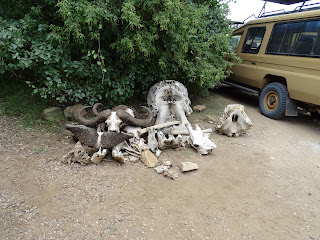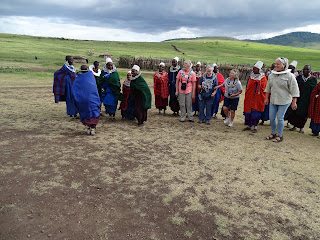This was our last morning at the Serengeti Serena Lodge so we made sure to chow down on the tasty pancakes at the breakfast buffet. They were actually a little more like a crepe but they were delicious and I put raw honey on mine which only enhanced the flavors. The juices were always fresh but I think we all preferred the pineapple. Before we left we had to stop in and say good bye to our friend in the gift shop. We had met this young man the day before when we stopped in to buy candy for Steven and we started joking around. He told us that we made him smile. Truth was, he made us smile!
 |
| Checking out. The room keys were kept in the wooden bowls behind the desk. |
 |
Our friend from the gift shop. He taught me how to say good night in Swahili.
Usiku Mwema |
Today's drive would be a long one. The first part would be a game drive through the Serengeti. Originally we thought we would be seeing the Wildebeest migration but that didn't happen. We did see some of the early migration and instead visited a Rhino Conservation Research Center that was very informative. I never tired of the expanse of the Serengeti. It was like an ocean of waving grasses that stretched as far as the eye could see. Lying within the grasses and kopjes were her treasured wildlife.
 |
The road out was quite busy today.
Wart Hogs |
 |
| And a troop of baboons! |
 |
| It is difficult to see, but this mom has her baby on her back. The very small babies hang on to mom's belly. |
 |
| He looks as though he would be ready for an Ohio snow! |
 |
| This female had to stop for her little one to grab a snack. |
 |
| Another leopard sighting |
 |
| He is lying on the lower right branch of the largest umbrella tree. |
 |
| And here we are heading into the Serengeti |
We made a stop at a very remote Wash Room and found it rich with several bird species I had not seen. It was a very serene area.
 |
| Speckle-fronted Weaver |
 |
| Our rest area with a view |
 |
You should know this one
White-headed Buffalo Weaver |
 |
Superb Starling
These were quite common everywhere we went but
this was one of my better photos |
 |
| Silver Bird |
 |
| The Wash Room |
 |
| Female Fan-tailed Widow Bird (?) |
After our morning break we headed further into the Serengeti to see what we could find. There was a large lake that supported a herd of giraffe and zebras and as we traveled on we saw a large herd of elephants taking a rest under an Umbrella tree. It was a bumpy but very relaxing driving day.
 |
The Yellow-billed Oxpecker, not to be confused with the Red-billed Oxpecker. They were nearly identical except the
yellow-billed had yellow at the base of his beak! |
 |
| I loved how the tusks nearly touched |
 |
| Red-headed Agama, a small lizard |
 |
| This was the first lion we had seen napping in a tree. |
 |
| Once again I was amazed at Steven's spotting abilities. |
We stopped for lunch at a Rhino Conservation Research Station. In 1985 there were only 2 surviving female black rhinos in this area. They transported a viable male into the area and today there are around 30 rhinos. We had lunch here and one of the researchers talked with us about his work.
 |
| Lunch with a view of birds and Tree and Rock Hyrax. |
 |
Steven pointed out this rare find, even more difficult to capture on my camera.
African Paradise Flycatcher |
 |
| A map of the area |
 |
| Our research lecturer |
 |
| A Rock Hyrax, there were also tree hyrax but I couldn't find one to photograph |
After lunch we drove on towards the Migration river in hopes of seeing some of the migration but time made it impossible to get there with enough time to visit the Maasai Village. We explored a few of the kopjes looking for rhinos but after a brief search we headed our jeep towards the Ngorongoro Crater, our final destination.
 |
| I was captivated by the way these impala looked like a drill team! |
 |
| Black-shouldered Kite |
 |
| After several more hours, the terrain began to change as we left the Serengeti behind and began our ascent to the Ngorongoro Serena Lodge. |
 |
| Wildebeest |
 |
| And this....this is an Eland. And we still couldn't identify him! Poor Steven!! |
Everyone in our group had signed up to visit one of the many Maasai villages that were scattered about. When the Serengeti became a National Park the Maasai were moved outside the park boundaries. The Maasai are still rich in their ancient traditions as herders of livestock. They can no longer hunt lions but I believe they can kill a lion if they are threatened. The men still have several wives and a hut for each. The village was quite primitive and their diet consists of only 3 things. Milk, blood and meat. No fruits or vegetables or breads.
 |
| As we climbed in elevation we began seeing Maasai with their livestock. |
 |
| The Maasai wear bright clothing so they can be seen for long distances. |
 |
| The women greeted us in their ceremonial clothing |
 |
| When we arrived, the Maasai performed a welcome dance |
 |
| Steven, our driver participated, although his tribe, near Kilimanjaro, is not Maasai. |
 |
| The women invited us to join them and shared their necklaces. |
 |
| Donna, the "free-spirit" in our group was up for anything. |
 |
| Making fire |
 |
| Touring the village |
 |
Inside the hut. No windows, only a small smoke hole in the roof.
There were two beds, one for the children and one for the parents.
There was a cooking fire and a stall off to the side where they would bring the young calves in at night. |
 |
| Our guide was one of the chiefs sons. |
 |
The huts are coated with mud, the roof with grasses and cow dung.
Yes there were many flies. |
 |
| This was the chief's home. |
 |
| These were taken inside the school |
 |
| The chief's son took our picture outside one of the newer huts. |
After leaving the Maasai village I was filled with a mixture of emotions. First and foremost I was grateful to have had a glimpse into a culture as ancient as the Maasai. I know that as a group they have experienced many changes to their lifestyle but have still managed to keep their identity. The government has moved their villages and in the last 10 years have enforced laws to protect the rights of women in the tribe. They now trade with Western visitors and perform their ceremonial dances at the nearby lodge to supplement their income. Their children have a school in the village and learn English. Still there was something about the joy we saw on the faces of the little ones and the simplicity of a life where contentment is based solely on their ability to survive in this harsh environment. Everyone in the village has a role that is integral to the tribe. The fact that there is very little choice in these gender based roles saddens me.
Our lodging for tonight is the beautiful Ngorongoro Serena Lodge, the lodge with the best view yet.
























































































No comments:
Post a Comment